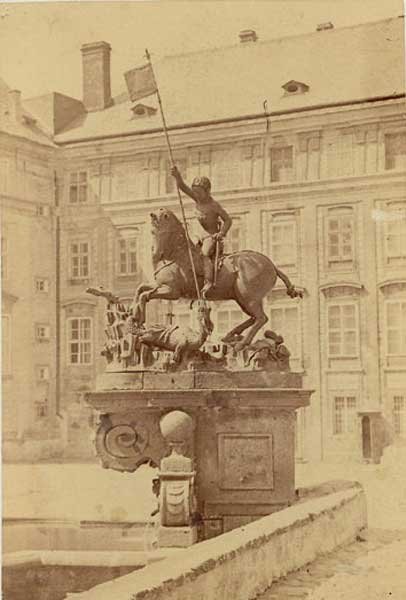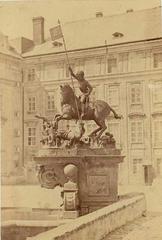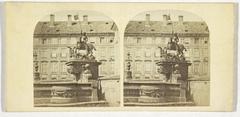
Statue of Saint George at Prague Castle: Visiting Hours, Tickets, and Historical Significance
Date: 15/06/2025
Introduction
The Statue of Saint George at Prague Castle is one of the most captivating monuments in Central Europe, embodying the intersection of medieval artistry, Christian symbolism, and Czech national identity. Cast in 1373 by the Transylvanian brothers Martin and George of Cluj, this bronze equestrian statue is among the oldest monumental free-standing bronzes north of the Alps, predating the Renaissance revival of equestrian sculpture in Italy (studiahercynia.ff.cuni.cz). Its depiction of the legendary Saint George slaying the dragon has made it an enduring symbol of courage, faith, and protection, echoing the spiritual and historical currents that have shaped Prague for centuries.
Prominently located in the Third Courtyard of Prague Castle, adjacent to St. Vitus Cathedral, the statue stands not only as a masterpiece of Gothic metallurgy but also as a witness to the political and ceremonial history of Bohemia (Prague Castle Official). Today, visitors can marvel at a faithful replica outdoors, while the original is preserved in the National Gallery Prague. This guide provides a comprehensive overview of the statue’s history, artistic features, practical visiting tips—including hours, ticketing, accessibility, and travel directions—and suggestions for nearby attractions to maximize your Prague Castle experience.
Contents
- Introduction
- Historical Background
- Origins and Creation
- Artistic Features and Iconography
- Placement, Movement, and Conservation
- Visiting the Statue
- Opening Hours and Tickets
- Directions and Accessibility
- Nearby Attractions and Tours
- Symbolism and Cultural Significance
- Frequently Asked Questions (FAQ)
- Practical Visitor Information
- Summary and Recommendations
- Sources and Further Reading
Historical Background
Origins and Creation
Commissioned in 1373, the Statue of Saint George was crafted in bronze by Martin and George of Cluj (Kolozsvár), renowned for their technical skill and artistic vision (studiahercynia.ff.cuni.cz). At the time, Cluj was part of the Kingdom of Hungary, reflecting the era’s dynamic cross-regional artistic exchanges. The statue’s creation marked a major milestone in European sculpture, as large-scale bronze casting had been virtually lost since antiquity.
Artistic Features and Iconography
The statue depicts Saint George, mounted on a rearing horse, triumphantly spearing the dragon beneath him. The composition is dynamic and charged with energy, reflecting influences from classical Roman equestrian statues and the emerging Gothic naturalism of the 14th century (smarthistory.org). Notably, the focus is on the duel itself, omitting the princess figure common in later Saint George iconography. The anatomical realism, intricate armor, and expressive movement reveal the advanced metallurgical and artistic techniques of its creators.
Placement, Movement, and Conservation
Originally installed in the Third Courtyard of Prague Castle, the statue quickly became a focal point for royal ceremonies and public gatherings. It was prominently featured during the coronation festivities of Maximilian II in 1562 and has remained a cherished landmark ever since (studiahercynia.ff.cuni.cz). The statue was incorporated into various fountain settings over the centuries, with the current fountain designed by the architect Jože Plečnik in the 20th century (extravaganzafreetour.com). To ensure its preservation, the original statue was moved indoors in 1967 and can now be viewed in the National Gallery Prague, while a high-quality replica stands in the castle courtyard.
Visiting the Statue of Saint George at Prague Castle
Opening Hours and Ticket Information
-
Castle Grounds (including Third Courtyard and the statue’s replica):
- Open daily: 6:00 AM – 10:00 PM
- Admission: Free of charge; no ticket required to view the outdoor replica.
-
Interiors and Exhibitions (including the original statue in the Story of Prague Castle exhibition at the Old Royal Palace):
- Summer (April–October): 9:00 AM – 5:00 PM
- Winter (November–March): 9:00 AM – 4:00 PM
- Tickets: Required for entry to interiors. The exhibition with the original statue is included in the Prague Castle circuit ticket (approx. 450 CZK as of 2025). Tickets are valid for two consecutive days (Prague Castle Official).
Directions and Accessibility
- Public Transport: Tram lines 22 and 23 stop at Pražský hrad (Prague Castle). The Malostranská metro station (Line A) is about a 15-minute walk uphill.
- Castle Entrances: The Pohořelec entrance is recommended for shorter security lines (Miss Tourist).
- Accessibility: Castle courtyards are mostly wheelchair accessible, though cobblestones and slight inclines exist. Assistance and ramps are available in key areas.
Practical Visitor Tips
- Best Times to Visit: Early mornings (before 10:00) or late afternoons (after 16:00) offer fewer crowds and better lighting for photography (Prague Tourist Information).
- Photography: Freely allowed outdoors; flash may be restricted in indoor exhibitions.
- Facilities: Restrooms, cafés, and souvenir shops are available within the castle grounds (Free Walking Tour Prague).
- Security: All visitors pass through security checks; large bags are discouraged.
Nearby Attractions and Guided Tours
- St. Vitus Cathedral: Prague’s grandest Gothic church, adjacent to the statue.
- Old Royal Palace: Houses the original statue and historic Vladislav Hall.
- St. George’s Basilica: One of Prague’s oldest churches, famed for its Romanesque architecture (catholicshrinebasilica.com).
- Golden Lane: Picturesque medieval street within the castle complex.
- Changing of the Guard: Every hour from 7:00–20:00 (summer), 7:00–18:00 (winter); noon ceremony includes fanfare (Prague Tourist Information).
Guided tours are highly recommended for deeper insight and are available in multiple languages. Audio guides can be rented from the Information Centre in the Third Courtyard (Miss Tourist).
Symbolism and Cultural Significance
Saint George was revered in medieval Bohemia as a model of chivalric virtue and a celestial protector of the realm. The statue’s equestrian format alludes to Roman triumphs and the ideals of Christian knighthood, reinforcing the legitimacy of the Bohemian monarchy (studiahercynia.ff.cuni.cz). Today, the statue remains a powerful symbol in Czech culture, celebrated in festivals, literature, and art.
Frequently Asked Questions (FAQ)
Q: Do I need a ticket to see the Statue of Saint George?
A: No, the outdoor replica in the Third Courtyard is free to view. A ticket is only needed to see the original indoors.
Q: What are the best visiting hours?
A: Early mornings and late afternoons are best for avoiding crowds and capturing the statue in ideal light.
Q: Is the statue wheelchair accessible?
A: Yes, the courtyards are mostly accessible, though some cobblestone areas may be uneven.
Q: Can I take photographs?
A: Yes, photography is allowed outdoors. Indoor restrictions may apply.
Q: Are guided tours available?
A: Yes, guided tours and audio guides are available in several languages.
Practical Visitor Information
- Restrooms: Located near St. Vitus Cathedral entrance and between Golden Lane and Jiřská Street (small fee applies).
- Food and Drink: On-site cafés and kiosks are available, but prices are higher than in the city center.
- Seating: Limited near the statue; benches available elsewhere in the courtyards.
Summary and Visitor Recommendations
The Statue of Saint George at Prague Castle offers a unique window into the artistry, legend, and history of the Czech lands. Whether viewed outdoors as a striking centerpiece of the Third Courtyard or examined up close in the Story of Prague Castle exhibition, the statue is a must-see for anyone interested in medieval art and Prague’s cultural heritage. Plan your visit during off-peak hours, take advantage of guided tours, and explore the surrounding historical sites for a comprehensive and enriching experience.
Before your visit, check the latest opening hours and ticket information on the official Prague Castle website. Enhance your experience with the Audiala app for in-depth audio guides and stay connected via social media for news and updates.
Sources and Further Reading
- The Statue of Saint George at Prague Castle: History, Visitor Information, and Cultural Significance (studiahercynia.ff.cuni.cz)
- Prague Castle Official: Statue of St. George
- Visiting the Statue of Saint George at Prague Castle: Artistic Significance and Practical Guide (smarthistory.org)
- Prague Castle Sightseeing (praguetouristinformation.com)
- The Horses of Prague and Related Artworks (extravaganzafreetour.com)
























































































































































































